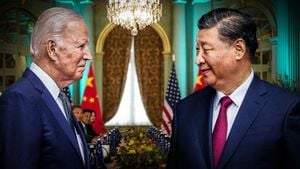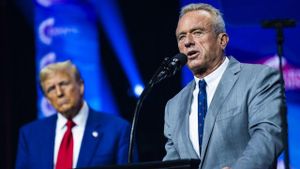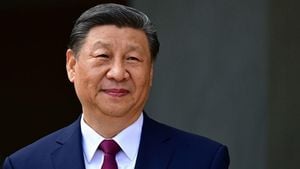Donald Trump’s transition from candidate to President had been closely watched and, at times, explosive. Trump embarked on this incredibly ambitious venture after winning the 2016 election, promising to change the tone and direction of Washington, D.C. But the move was not without its challenges, especially as he began selecting his cabinet members—a process filled with unprecedented character clashes and political maneuvers.
First and foremost, Trump's choice of cabinet officials generated significant headlines. These appointments not only shaped his administration's policies but also sent messages about his intentions for the nation. The mix of seasoned politicians, business magnates, and ones with no government experience brought both excitement and uncertainty. For example, the selection of Rex Tillerson, the former CEO of Exxon Mobil, as Secretary of State raised eyebrows. Critics questioned how someone with no diplomatic experience could navigate the intricacies of international relations, though supporters praised his business acumen and connections.
Then there was Ben Carson, the famed neurosurgeon, chosen to lead the Department of Housing and Urban Development. Many were surprised by this pick, as Carson had no prior experience in housing policy. This cabinet selection seemed to reflect Trump’s broader strategy—favoring loyalty and personal rapport over experience.
Equally contentious was Trump’s pick for Secretary of Education, Betsy DeVos, who came from wealthy donor backgrounds and had advocated for school choice and charter schools. Her nomination faced intense scrutiny. Critics argued her lack of experience within public education could lead to policies dismissive of the traditional public schooling system.
We saw the emergence of some major power dynamics throughout the transition. Trump’s picks often mirrored his business approach: loyalty and personal success mattered more than credentials. This became particularly evident with some advisors who clashed with traditional Republican values, like Steve Bannon, who entered the fray with his far-right ideologies.
Initial concerns sprouted as several Cabinet nominations faced backlash from both Republicans and Democrats. A significant early confrontation involved Jeff Sessions for Attorney General. His nomination was delayed due to scrutiny surrounding his past comments about race and civil rights, raising fears among advocates for systemic equality. Protests erupted from various corners of the nation, showing public dissent against some key appointments.
Meanwhile, the administration’s communication strategy also raised eyebrows through the transition phase. Many pundits noted Trump's unconventional approach of using social media to inform the public and criticize the media continued to be at odds with traditional presidential communication protocols. While some lauded this direct communication style as refreshing, others condemned it as reckless.
Fast forward to Trump officially taking office, it became evident how these cabinet picks would shape his presidency. The tension between Trump and established political norms became apparent. Cabinet meetings occasionally bordered on farcical, as many members had to toe the line laid down by Trump to maintain favor. A notable example occurred during the televised cabinet meeting when members praised Trump—the awkwardness laid bare the dynamics of loyalty versus meritocracy.
The uncertainties of his health policies reform stirred worries, especially with Tom Price helming the Department of Health and Human Services. Political rhetoric suggested price changes, which left millions anxious over healthcare accessibility. Here was another moment reflecting Trump’s puzzle-like administration, with various cabinet members voicing contradictory views on hot-button issues.
Controversies continued as more tweets and statements from Trump sent waves across different sectors. The impact of these tweets on the stock market was both immediate and palpable—investors adjusted before policies even became tangible realities. The unyielding, often unpredictable, nature of Trump's presidency was reflected through this cabinet dynamic and the media’s growing scrutiny.
While on the topic of cabinet scrutiny, we can't overlook the resignation of various key figures under mounting pressure. The first to go was Michael Flynn, his National Security Advisor, who resigned just weeks after being appointed. This came following revelations about his misleading statements concerning contacts with Russian officials, marking the beginning of concerns surrounding the integrity of Trump’s appointments.
Future cabinet appointments hinted toward populist priorities, removing the idea of elitism typically associated with the establishment. The consistent push for deregulation particularly under Scott Pruitt at the EPA signaled how Trump’s cabinet was shaping reality as it acted on objectives contrary to environmental advocacy attempts.
Trump’s administration navigated tricky waters as more challenges arose. For example, the handling of programs under Tom Price evolved as lawmakers fell under increased pressure for healthcare reform. Rhetoric shifted dramatically tailside of the unsavory remarks made during the transition period; the Trump administration’s trending direction was becoming clearer.
The impact of these cabinet picks emerged not only through their respective departments but also through the shaping of public perception and policy influence across the board. Debate raged early and often—each appointment brought with it layers of controversy but also the prospect of significant reform and change.
Still, critics continued to draw the connection between Trump’s picks and the broader narrative surrounding privilege, loyalty, and governmental experience. Voters who saw their interests reflected within cabinet picks felt reassured, but others remained wary, questioning whether these choices would truly benefit the American people or falter due to individual ambitions.
With Obama’s administration still fresh, the stark contrasts between the two cabinets offered quite the spectacle. The surrounding debates often underscored these ideological divergences—forging divides not easily healable during this political tension. Trump's administration vowed to dismantle some of Obama’s policies, which inevitably drew lines of contention across political ideologies.
The overall sentiment surrounding Trump’s cabinet picks serves as both a reflection and distortion of the tumultuous political climate. The unpredictability following the transition meant Americans were likely to witness both dramatic turns and steadfast resolutions over the course of the following years. Each appointment told part of the story, wrapping up the drama and stoking discussions—a fine balance between ambition and stability shaping the essence of Trump’s endeavor.



